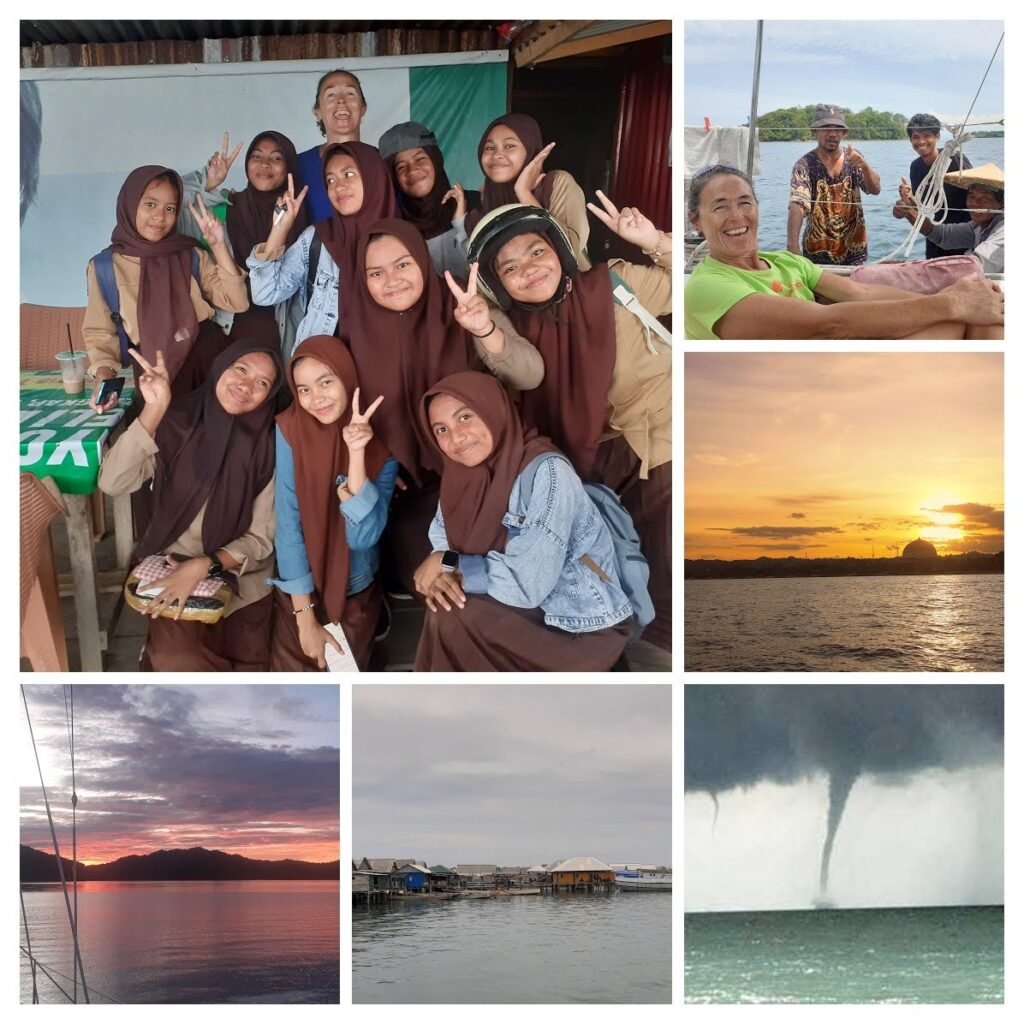From Sorong on the island of Papua to Lombok, just before Bali, is only 2500 km. A bit more than half an Atlantic crossing and less half the East coast of Australia. A “short hop”.
But at the moment the North West Monsoon is blowing which means that the current is always against you and the wind – if there is any wind so close to the equator – is mostly a light breeze also against you. Unlike in the Atlantic the seas are studded with coral ringed islands, islets and reefs that need to be avoided and always appear exactly where they are not needed. This all made for an interesting trip.
Things started well. We sailed gently to a channel between two islands and then anchored and waited for the current to turn. In the morning we more drifted than sailed the entire channel and were spat out the other end. A few miles further and we saw standing waves ahead where our bit of current met a stronger current running against us. After a few hours of trying to make headway, we had to use the engine to “break through” to less turbulent waters on the other side.

The next days were hard sailing. Sometimes we were heading the right way but often we were tacking to not lose ground. The engine was needed again to avoid being sucked on to Buru Island by the current running between the islands. And, of course, there are the thousands of fish traps, fishing buoys and floating bamboo islands everywhere – mostly unlit.
Eventually we sighted Sulawesi to the west and finally anchored in a bay off a holiday village. When I was 16 I read of the jungles of Sulawesi and decided that this island was some where I wanted to visit and now, only 44 years later, we were anchored below the jungle covered hills. Sometimes you only need patience.
We spent the next week working our way under Sulawesi enjoying the incredibly friendly people. In one village we were given tomatoes and in the next town a jar of honey. Everyone we met wanted a photograph with us even turning their scooters round and coming back to ask. We felt like rock stars surrounded by schoolgirls who all needed a photograph and to try a few words of English. We anchored off a lonely reef, next to a village built on stilts and up a river that cut through the coral reef. With Artemis we can really leave the “beaten track”.
One day both mobile phones disconnected from the Internet claiming that our SIM cards were invalid. In the next village we found the “phone mechanic” but he could not help. It turns out that, after 90 days, Indonesian customs block your phone unless you pay them 40% import tax. So we now own a second hand local phone that is tax paid. While the guy was working on our problem, Heidi was surrounded by local ladies enjoying pictures of Allgäu, snow, our children and our journey in our new “picture book”.
Back online we continued west. Actually we went north then a bit west then south. It was further but avoided the strong current so was actually sailable. Sailing is often about going the long way to get there eventually. It was during this trip that we realized that our marine radio no longer worked and saw our first tornado just off to port.
During our last stop in Sulawesi we met Aul who fed us crab, took us home to meet her family, helped us shop in the Sunday market and took us to the swimming pool where, this being a Muslim country, Heidi and all the other women swim fully clothed. We were made to feel like honored guests and enjoyed the chance to meet so many locals and learn about their life.

By the time we left Sulawesi we had used half our diesel supply and out in the islands you can not buy high quality fuel suitable for our engine. But the weather forecast promised wind and we planned a route to avoid the strong currents so we thought we could easily reach Lombok.
On the first day we were in the shadow of the islands but a storm/tornado/who knows what ripped in to us with incredible force and ripped the screws that secure the main sail traveller out of their threads. Luckily we had a safety rope installed and even more luckily neither of us was in the way of the flying parts. With a rope we managed to make a repair to allow us to continue.
In the night we were making good progress until we entered an area full of fish traps. We just managed to turn to avoid a large, unlit bamboo construction that could only be seen in the dark because of the hundreds of white seagulls sat on it. As a result we took down most of the sails to drift slowly until daylight. No progress is better than a wrecked boat.
The next days were frustrating. No wind at all but a constant current against us. Instead of sailing we burnt fuel to keep moving against the current, make way westwards and avoid reefs. Over a hundred miles away from Lombok we ran out of fuel and were at the mercy of the current. Luckily a passing fisherman swapped us twenty liters of diesel for a fuel canister. This was just enough to reach the port of Badas where we were overjoyed to see the yacht Moon River at anchor. Our friends who we met last Christmas had a phone number for a taxi driver and lent us their diesel canisters to refuel.
As we tried to lift the anchor in Badas we discovered that it was broken. It will turn but lacks the strength to lift the anchor so we pulled it up from hand which is not good at our age. No anchor winch meant making the run directly to the marina in Lombok in one overnight run while hugging the coast to mitigate the current.
As the sun rose over Lombok’s volcano we put the water maker on and found it no longer works. Yesterday it made drinking water but today the water is brackish.
Finally we reached Lombok and tied to a mooring buoy. Our visas run out in five days, our main sail traveller is broken, the marine radio does not work and we don’t have a working anchor winch or water maker. So we did the best thing you can do in such a situation and went to the restaurant for brunch and ice cold coke.



It’s when everything breaks down, that makes it interesting. You poor things.
Beautiful. So nice to see you again. I thought for awhile that you had settled permanently on an isolated island.